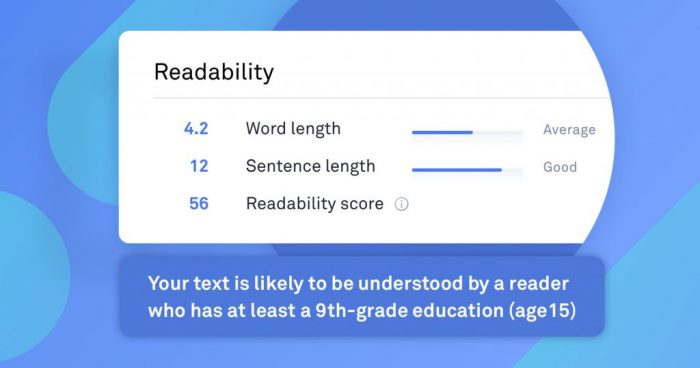Readability is key to engaging content that increases your SEO rankings, engagement and improves conversion rate. But, it’s not always easy to write readable content. What’s not to love about that?
All sectors, from digital marketers to medical writers, recognize the value of readability. By ensuring the readability of a content – a patient care guide, a promotional bit for a particular brand, or an informative article, you increase your reader’s chances of understanding your message.
Do you know how to increase readability score? Well, in this article, I will explain 5 steps that should help you make your text more easily understood, but firstly I will explain the significance of the term “readability”.
What is Readability
Readability is about making content clear and easy to understand. Every writer aims to have their readers comprehend a specific or purposeful message. For websites, focusing on readability increases your audience’s chance to read and interact with your content. For this reason, readability should be a natural part of content management.
Applying a readability formula to your content can help you decide its reading difficulty. A readability formula is a mathematical equation that measures the difficulty experienced by individuals who read a given text and the linguistic characteristics of that content.
Most readability formulas analyze a text’s average sentence length, number of familiar words, syllable count, and so on, and output a reading or grade level based on these factors. Using a readability formula to determine the reading difficulty of your message is helpful to ensure reader comprehension, but one should not solely rely on it.
How to Increase Readability Score
A readability score can point out to you roughly what level of education someone will need to read some text easily. Achieving a higher readability score isn’t as hard as it sounds. Here are five practical tips for getting set on the right track:
Write in a Conversational Tone
The people reading will be humans. So, make it a habit to address your readers in a personal tone. Use words like “you” and “I” to hook readers and engage them to keep reading your content. They need to feel like they are having a real-life conversation with you while reading your content. In this scenario, it’s helpful to avoid complicated words. Bring information down to a human level, so people read and immediately understand what you’re trying to communicate.
Keep Paragraphs Short and Spaced Well
Paragraphs shouldn’t contain more than 4-5 sentences. Most readers skip the paragraphs containing more sentences. You should craft your article, blog post, or any other content by considering scanners and speed readers. The section should include only one small idea and contain lots of blank space. It will reduce the chances of readers skipping a line.
Use Active Voice
The more active voice you use, the higher the readability score you get. Many text editors, including M.S. Word, suggest you use active voice over passive one. Sentences in the active voice are easier to understand, direct, strong, and appealing, whereas passive ones sound indirect and sometimes hard to read.
Don’t Use Filler Words
Words that are unnecessary and that lengthen the sentence are filler words. In middle school, we all used to add the filler words to meet the word count, but keep it to the point in professional writing. For example:
Make use of this tool– Use this toolThere are some bloggers ignoring SEO– Some bloggers ignore SEO
The structure is essential
You may have some useful things to say, but unless you structure your writing in a manner that is helpful and useful for the reader, the chances are that your message won’t translate.
You should think about the story that you want to convey in the content. What are the key messages? What does the reader should know before they can engage with your messages?
You need to think about what the reader needs to know first and the focus of the article. Don’t write too much information into a single paragraph. This will make it difficult for the reader to follow, especially if they will read on a smaller device like phone or tablet. All in all, keep it simple.
How to Increase Readability Score in Grammarly
Readability scores are a number that tells us how easy it will be for someone to read a particular content. Grammarly’s readability score is based on the average length of the sentence and words in your document, and it’s using a formula known as the Flesch reading ease test.
When you work on a document in the Grammarly Editor, you should open up the writing assistant and click Performance. Under the Readability section, there is a numerical score. It is logical; the higher the number, the easier it is to read your document. To achieve this, you should aim for a score of 60 or higher. With a score of 60, your content will be clear, and easy to understand for most individuals with at least an eighth-grade education. (That refers to an average 13-year-old, in case you’re unfamiliar with the U.S. grade levels.)
What if you’re writing content for adults as readers? Does a readability score with a number 70 mean you sound such an eighth-grader? No! Remember, readability scores don’t measure your writing skills, vocabulary size, or the sophistication of your argument. Instead, it tells you how much energy your reader will have to expend to absorb what you’re saying.
Fortunately, Grammarly tool offers a variety of suggestions to help you write concisely and find the exact word you need in every situation, and for any audience. They include correctness, clarity, engagement, delivery, and the style guide.
Conclusion
Now that you know how to increase readability score in your content, it might be evident that making your content readable is essential, but many content writers make the mistake of not considering how easy (or hard) it is for visitors to make sense of their text. If you don’t optimize your content to be highly readable, you may find that readers will bounce off your site faster and return less frequently.
There is more to readability than just sentence and word length. In some cases, you will get a high readability score even if your content makes no logical sense. The same sentence has an identical readability score no matter what order the words are written.


